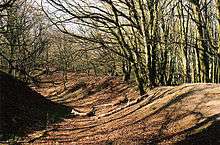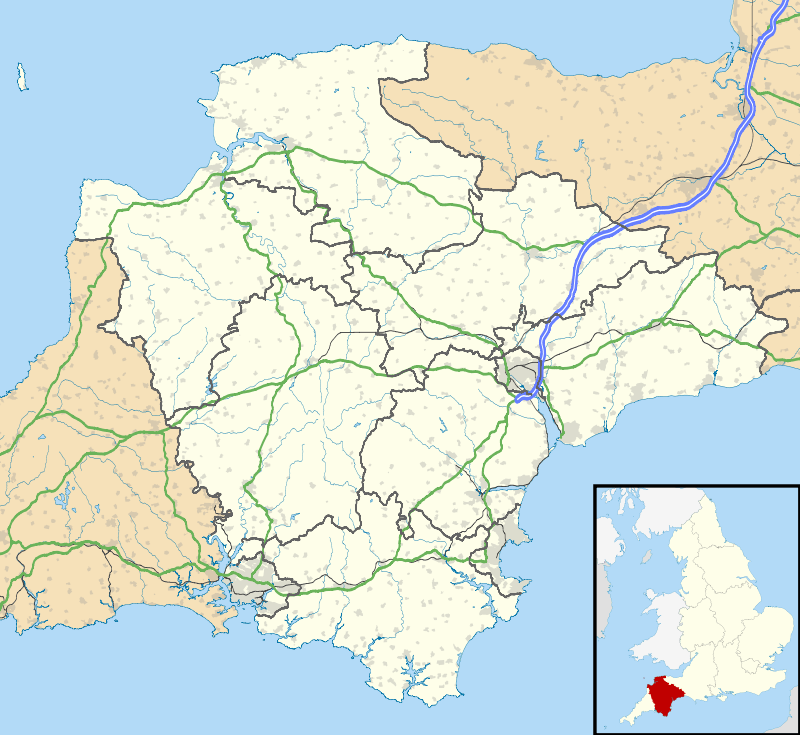Hembury
Hembury is a Neolithic causewayed enclosure and Iron Age hill fort near Honiton in Devon. Its history stretches from the late fifth and early fourth millennia BC to the Roman invasion. The fort is situated on a south facing promontory at the end of a 240m high ridge in the Blackdown Hills. It lies to the north of and overlooking the River Otter valley and this location was probably chosen to give good views of the surrounding countryside as well as for defensive reasons.[1]
 Ramparts inside Hembury hillfort | |
 Shown within Devon | |
| Location | Hembury, Devon |
|---|---|
| Coordinates | 50.82061°N 3.26200°W |
| Type | Hillfort |
| History | |
| Periods | Neolithic, Iron Age, Roman |
| Site notes | |
| Public access | Yes |
| Website | http://www.hemburyfort.co.uk |
Stages of occupation
Originally a neolithic site, an Iron Age hill fort was later built on the same site.[2]
It was excavated between 1930 and 1935 by Dorothy Liddell. She identified a timber framed entrance to the causewayed enclosure and an oval arrangement of postholes in the middle which she interpreted as being a building destroyed by fire before the enclosure earthworks were built. Other evidence of neolithic occupation included pottery, flints, axes, querns and charred grain.[3]
During an excavation in the 1980s headed by Malcolm Todd, archaeological evidence was found on the site of Roman military occupation, suggesting a fort within the existing Iron Age site.[4]
Hembury ware
The site has given its name to some of the earliest Neolithic pottery in southern Britain after a large collection of pieces of this type of pottery were found during excavations by Dorothy Liddell.[5] Hembury ware pottery was generally characterised by round bottomed bowls with lug handles. Much of it was made further west, around The Lizard using Gabbroic clay and it was traded throughout the British Isles. It was made at the end of the fifth millennium BCE and early 4th millennium BCE.[6] Several pieces of Hembury ware Gabbro pottery are on display in the Royal Albert Memorial Museum in Exeter, Devon.[7]
References
- Historic England. "Hembury Fort (1018850)". National Heritage List for England. Retrieved 16 November 2016.
- Sellman, R.R. (1985). Aspects of Devon History. Exeter: Devon Books. pp. 7–13. ISBN 0-86114-756-1.
- Devon & Dartmoor Historic Environment Record. "Hembury Fort Neolithic Settlement". Heritage Gateway. Retrieved 16 November 2016.
- "Professor Malcolm Todd". The Times. 18 July 2013. Retrieved 18 July 2013.
- Historic England. "HEMBURY CAUSEWAYED ENCLOSURE (1181774)". PastScape. Retrieved 16 November 2016.
- Shaw, Ian; Jameson, Robert (2008). A Dictionary of Archaeology. John Wiley & Sons. p. 272. Retrieved 16 November 2016.
- "WELCOME TO HEMBURY FORT". Hembury Fort Management Team. Retrieved 16 November 2016.
External links
| Wikimedia Commons has media related to Hembury. |